Talent Management Practices in SME
VerifiedAdded on 2023/01/23
|10
|2378
|55
AI Summary
This study examines the talent management practices implemented in small and medium-sized enterprises (SMEs) for employee development and retention. It explores the effectiveness of these practices and the challenges faced in talent management in SMEs. The research aims to provide a theoretical rationale for talent management in SMEs and propose a framework for identifying talent characteristics in SMEs.
Contribute Materials
Your contribution can guide someone’s learning journey. Share your
documents today.
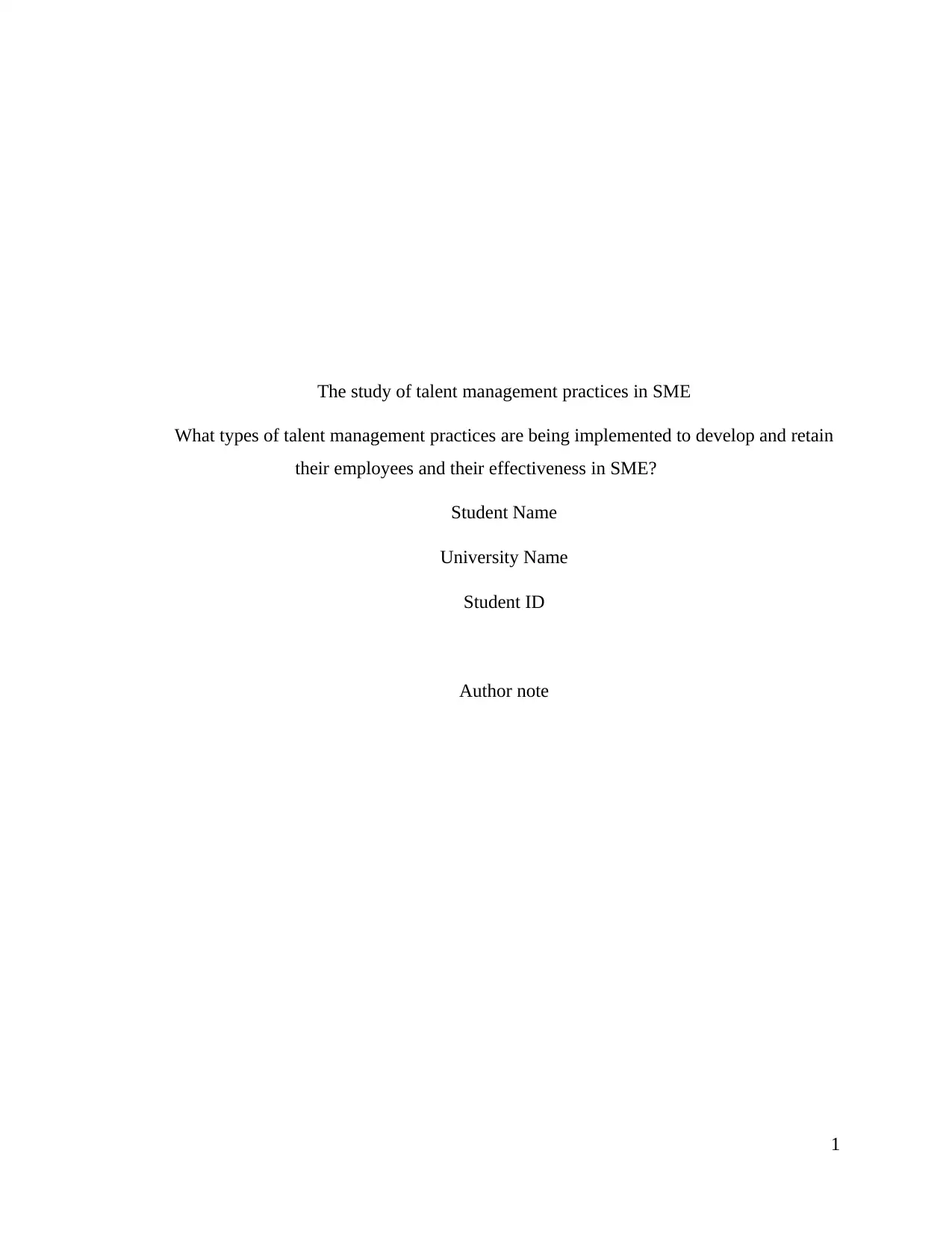
The study of talent management practices in SME
What types of talent management practices are being implemented to develop and retain
their employees and their effectiveness in SME?
Student Name
University Name
Student ID
Author note
1
What types of talent management practices are being implemented to develop and retain
their employees and their effectiveness in SME?
Student Name
University Name
Student ID
Author note
1
Secure Best Marks with AI Grader
Need help grading? Try our AI Grader for instant feedback on your assignments.
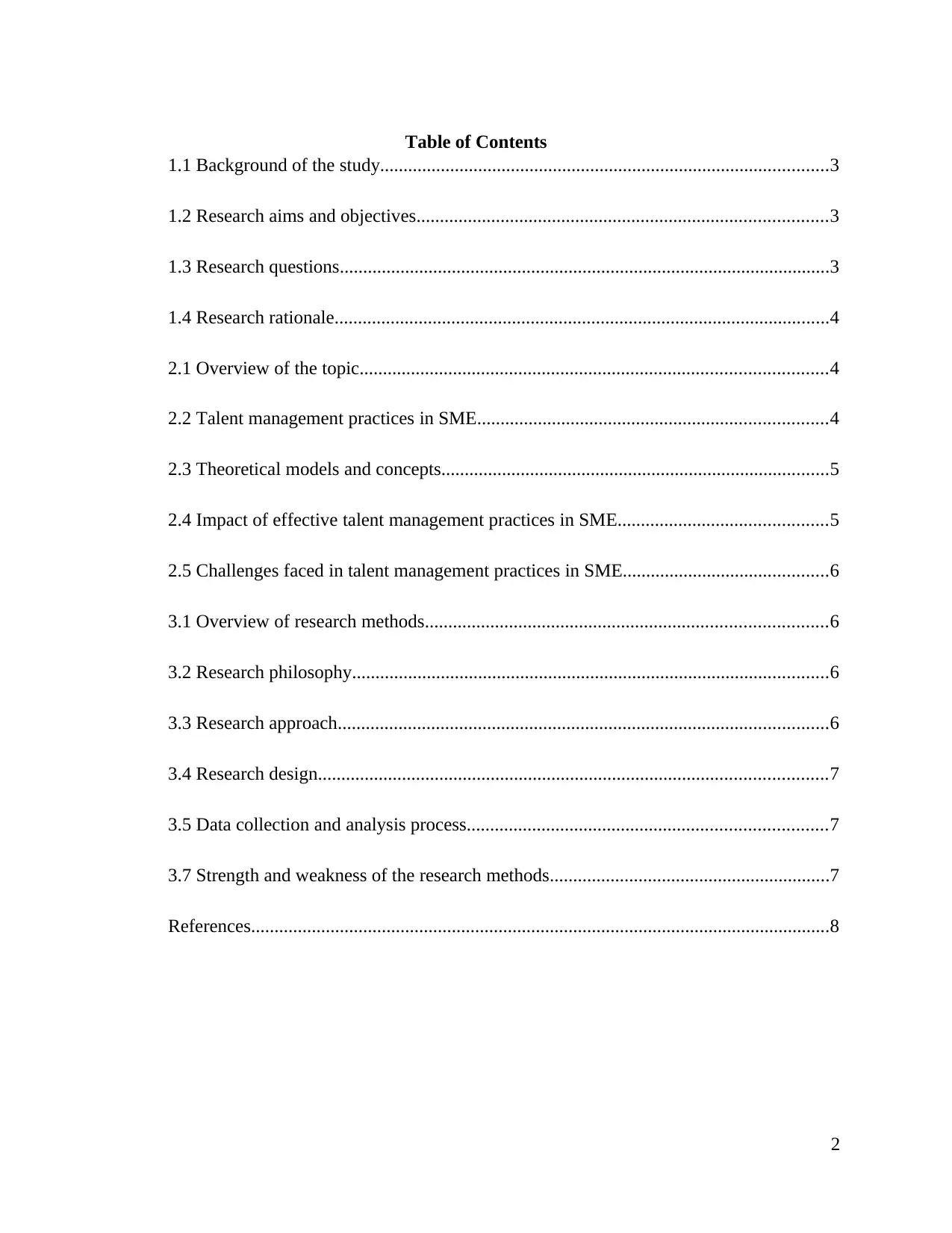
Table of Contents
1.1 Background of the study................................................................................................3
1.2 Research aims and objectives........................................................................................3
1.3 Research questions.........................................................................................................3
1.4 Research rationale..........................................................................................................4
2.1 Overview of the topic....................................................................................................4
2.2 Talent management practices in SME...........................................................................4
2.3 Theoretical models and concepts...................................................................................5
2.4 Impact of effective talent management practices in SME.............................................5
2.5 Challenges faced in talent management practices in SME............................................6
3.1 Overview of research methods......................................................................................6
3.2 Research philosophy......................................................................................................6
3.3 Research approach.........................................................................................................6
3.4 Research design.............................................................................................................7
3.5 Data collection and analysis process.............................................................................7
3.7 Strength and weakness of the research methods............................................................7
References............................................................................................................................8
2
1.1 Background of the study................................................................................................3
1.2 Research aims and objectives........................................................................................3
1.3 Research questions.........................................................................................................3
1.4 Research rationale..........................................................................................................4
2.1 Overview of the topic....................................................................................................4
2.2 Talent management practices in SME...........................................................................4
2.3 Theoretical models and concepts...................................................................................5
2.4 Impact of effective talent management practices in SME.............................................5
2.5 Challenges faced in talent management practices in SME............................................6
3.1 Overview of research methods......................................................................................6
3.2 Research philosophy......................................................................................................6
3.3 Research approach.........................................................................................................6
3.4 Research design.............................................................................................................7
3.5 Data collection and analysis process.............................................................................7
3.7 Strength and weakness of the research methods............................................................7
References............................................................................................................................8
2
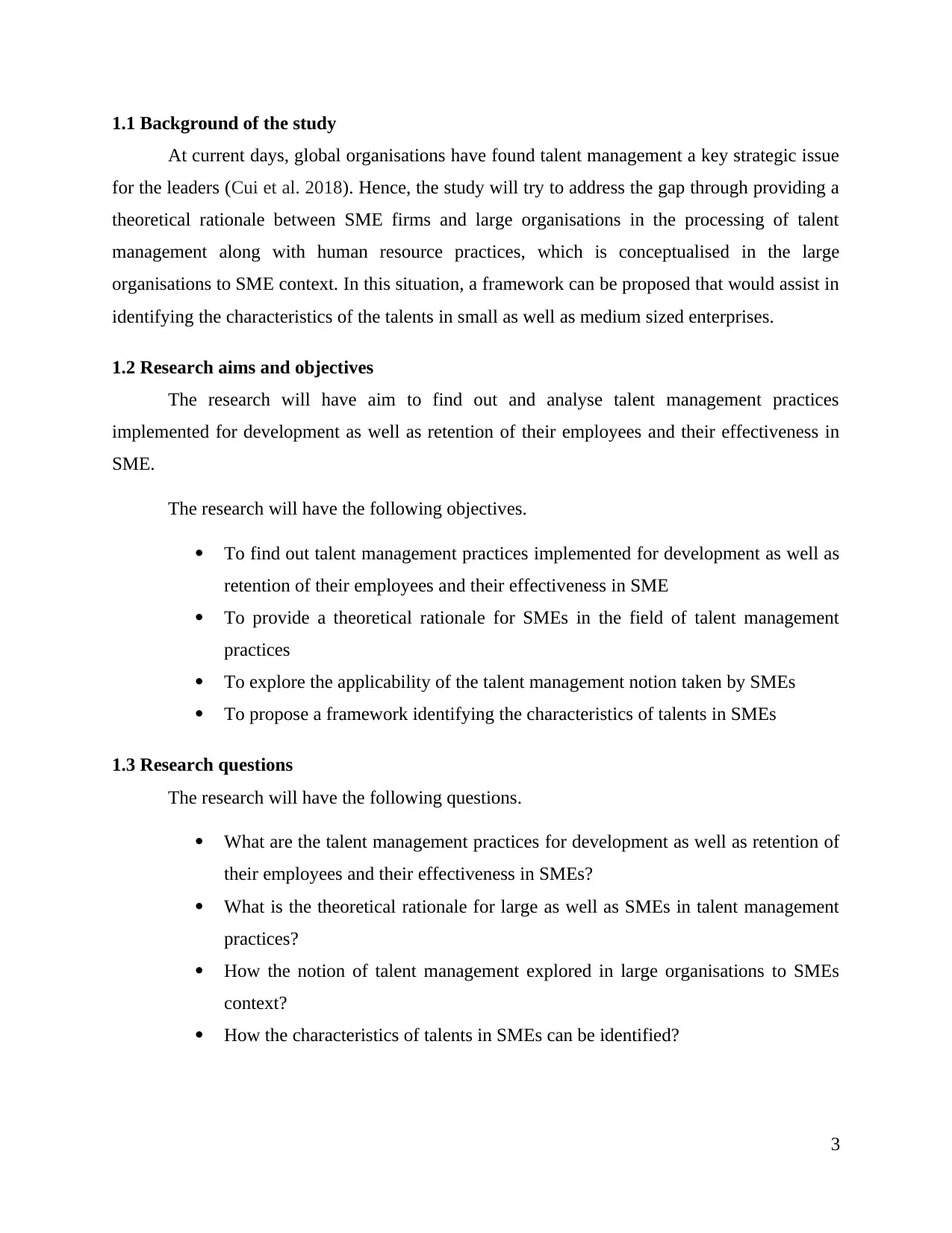
1.1 Background of the study
At current days, global organisations have found talent management a key strategic issue
for the leaders (Cui et al. 2018). Hence, the study will try to address the gap through providing a
theoretical rationale between SME firms and large organisations in the processing of talent
management along with human resource practices, which is conceptualised in the large
organisations to SME context. In this situation, a framework can be proposed that would assist in
identifying the characteristics of the talents in small as well as medium sized enterprises.
1.2 Research aims and objectives
The research will have aim to find out and analyse talent management practices
implemented for development as well as retention of their employees and their effectiveness in
SME.
The research will have the following objectives.
To find out talent management practices implemented for development as well as
retention of their employees and their effectiveness in SME
To provide a theoretical rationale for SMEs in the field of talent management
practices
To explore the applicability of the talent management notion taken by SMEs
To propose a framework identifying the characteristics of talents in SMEs
1.3 Research questions
The research will have the following questions.
What are the talent management practices for development as well as retention of
their employees and their effectiveness in SMEs?
What is the theoretical rationale for large as well as SMEs in talent management
practices?
How the notion of talent management explored in large organisations to SMEs
context?
How the characteristics of talents in SMEs can be identified?
3
At current days, global organisations have found talent management a key strategic issue
for the leaders (Cui et al. 2018). Hence, the study will try to address the gap through providing a
theoretical rationale between SME firms and large organisations in the processing of talent
management along with human resource practices, which is conceptualised in the large
organisations to SME context. In this situation, a framework can be proposed that would assist in
identifying the characteristics of the talents in small as well as medium sized enterprises.
1.2 Research aims and objectives
The research will have aim to find out and analyse talent management practices
implemented for development as well as retention of their employees and their effectiveness in
SME.
The research will have the following objectives.
To find out talent management practices implemented for development as well as
retention of their employees and their effectiveness in SME
To provide a theoretical rationale for SMEs in the field of talent management
practices
To explore the applicability of the talent management notion taken by SMEs
To propose a framework identifying the characteristics of talents in SMEs
1.3 Research questions
The research will have the following questions.
What are the talent management practices for development as well as retention of
their employees and their effectiveness in SMEs?
What is the theoretical rationale for large as well as SMEs in talent management
practices?
How the notion of talent management explored in large organisations to SMEs
context?
How the characteristics of talents in SMEs can be identified?
3
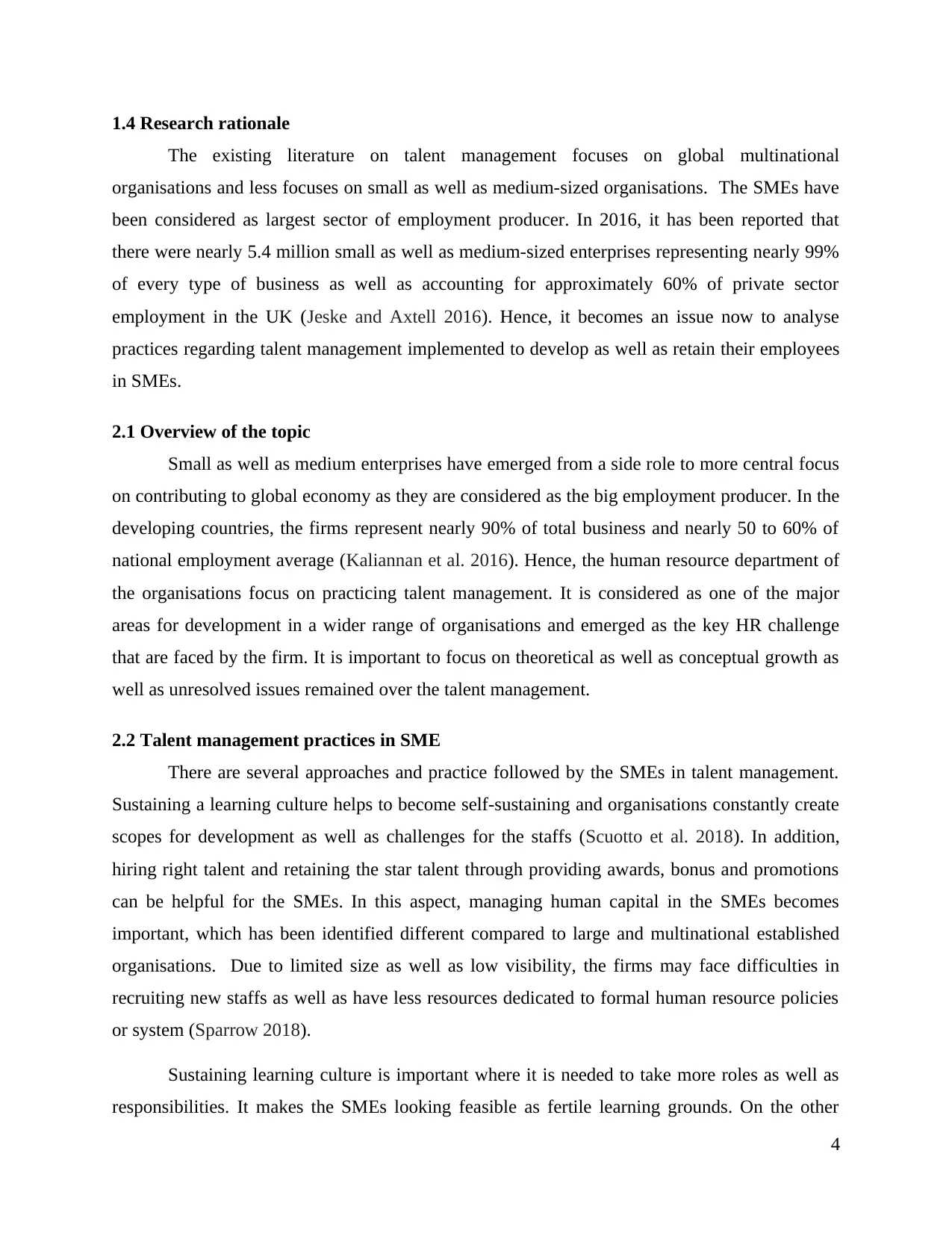
1.4 Research rationale
The existing literature on talent management focuses on global multinational
organisations and less focuses on small as well as medium-sized organisations. The SMEs have
been considered as largest sector of employment producer. In 2016, it has been reported that
there were nearly 5.4 million small as well as medium-sized enterprises representing nearly 99%
of every type of business as well as accounting for approximately 60% of private sector
employment in the UK (Jeske and Axtell 2016). Hence, it becomes an issue now to analyse
practices regarding talent management implemented to develop as well as retain their employees
in SMEs.
2.1 Overview of the topic
Small as well as medium enterprises have emerged from a side role to more central focus
on contributing to global economy as they are considered as the big employment producer. In the
developing countries, the firms represent nearly 90% of total business and nearly 50 to 60% of
national employment average (Kaliannan et al. 2016). Hence, the human resource department of
the organisations focus on practicing talent management. It is considered as one of the major
areas for development in a wider range of organisations and emerged as the key HR challenge
that are faced by the firm. It is important to focus on theoretical as well as conceptual growth as
well as unresolved issues remained over the talent management.
2.2 Talent management practices in SME
There are several approaches and practice followed by the SMEs in talent management.
Sustaining a learning culture helps to become self-sustaining and organisations constantly create
scopes for development as well as challenges for the staffs (Scuotto et al. 2018). In addition,
hiring right talent and retaining the star talent through providing awards, bonus and promotions
can be helpful for the SMEs. In this aspect, managing human capital in the SMEs becomes
important, which has been identified different compared to large and multinational established
organisations. Due to limited size as well as low visibility, the firms may face difficulties in
recruiting new staffs as well as have less resources dedicated to formal human resource policies
or system (Sparrow 2018).
Sustaining learning culture is important where it is needed to take more roles as well as
responsibilities. It makes the SMEs looking feasible as fertile learning grounds. On the other
4
The existing literature on talent management focuses on global multinational
organisations and less focuses on small as well as medium-sized organisations. The SMEs have
been considered as largest sector of employment producer. In 2016, it has been reported that
there were nearly 5.4 million small as well as medium-sized enterprises representing nearly 99%
of every type of business as well as accounting for approximately 60% of private sector
employment in the UK (Jeske and Axtell 2016). Hence, it becomes an issue now to analyse
practices regarding talent management implemented to develop as well as retain their employees
in SMEs.
2.1 Overview of the topic
Small as well as medium enterprises have emerged from a side role to more central focus
on contributing to global economy as they are considered as the big employment producer. In the
developing countries, the firms represent nearly 90% of total business and nearly 50 to 60% of
national employment average (Kaliannan et al. 2016). Hence, the human resource department of
the organisations focus on practicing talent management. It is considered as one of the major
areas for development in a wider range of organisations and emerged as the key HR challenge
that are faced by the firm. It is important to focus on theoretical as well as conceptual growth as
well as unresolved issues remained over the talent management.
2.2 Talent management practices in SME
There are several approaches and practice followed by the SMEs in talent management.
Sustaining a learning culture helps to become self-sustaining and organisations constantly create
scopes for development as well as challenges for the staffs (Scuotto et al. 2018). In addition,
hiring right talent and retaining the star talent through providing awards, bonus and promotions
can be helpful for the SMEs. In this aspect, managing human capital in the SMEs becomes
important, which has been identified different compared to large and multinational established
organisations. Due to limited size as well as low visibility, the firms may face difficulties in
recruiting new staffs as well as have less resources dedicated to formal human resource policies
or system (Sparrow 2018).
Sustaining learning culture is important where it is needed to take more roles as well as
responsibilities. It makes the SMEs looking feasible as fertile learning grounds. On the other
4
Secure Best Marks with AI Grader
Need help grading? Try our AI Grader for instant feedback on your assignments.
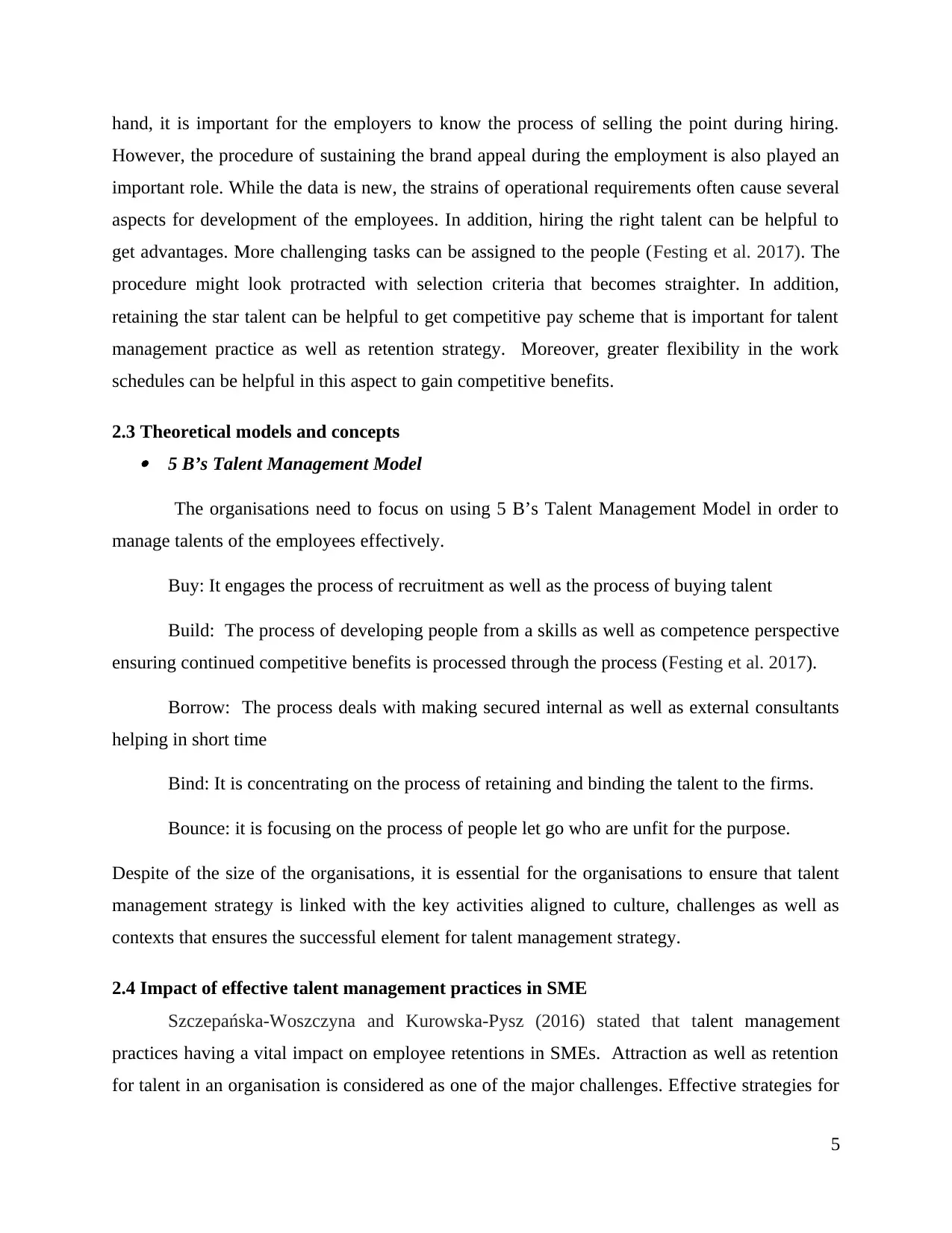
hand, it is important for the employers to know the process of selling the point during hiring.
However, the procedure of sustaining the brand appeal during the employment is also played an
important role. While the data is new, the strains of operational requirements often cause several
aspects for development of the employees. In addition, hiring the right talent can be helpful to
get advantages. More challenging tasks can be assigned to the people (Festing et al. 2017). The
procedure might look protracted with selection criteria that becomes straighter. In addition,
retaining the star talent can be helpful to get competitive pay scheme that is important for talent
management practice as well as retention strategy. Moreover, greater flexibility in the work
schedules can be helpful in this aspect to gain competitive benefits.
2.3 Theoretical models and concepts 5 B’s Talent Management Model
The organisations need to focus on using 5 B’s Talent Management Model in order to
manage talents of the employees effectively.
Buy: It engages the process of recruitment as well as the process of buying talent
Build: The process of developing people from a skills as well as competence perspective
ensuring continued competitive benefits is processed through the process (Festing et al. 2017).
Borrow: The process deals with making secured internal as well as external consultants
helping in short time
Bind: It is concentrating on the process of retaining and binding the talent to the firms.
Bounce: it is focusing on the process of people let go who are unfit for the purpose.
Despite of the size of the organisations, it is essential for the organisations to ensure that talent
management strategy is linked with the key activities aligned to culture, challenges as well as
contexts that ensures the successful element for talent management strategy.
2.4 Impact of effective talent management practices in SME
Szczepańska-Woszczyna and Kurowska-Pysz (2016) stated that talent management
practices having a vital impact on employee retentions in SMEs. Attraction as well as retention
for talent in an organisation is considered as one of the major challenges. Effective strategies for
5
However, the procedure of sustaining the brand appeal during the employment is also played an
important role. While the data is new, the strains of operational requirements often cause several
aspects for development of the employees. In addition, hiring the right talent can be helpful to
get advantages. More challenging tasks can be assigned to the people (Festing et al. 2017). The
procedure might look protracted with selection criteria that becomes straighter. In addition,
retaining the star talent can be helpful to get competitive pay scheme that is important for talent
management practice as well as retention strategy. Moreover, greater flexibility in the work
schedules can be helpful in this aspect to gain competitive benefits.
2.3 Theoretical models and concepts 5 B’s Talent Management Model
The organisations need to focus on using 5 B’s Talent Management Model in order to
manage talents of the employees effectively.
Buy: It engages the process of recruitment as well as the process of buying talent
Build: The process of developing people from a skills as well as competence perspective
ensuring continued competitive benefits is processed through the process (Festing et al. 2017).
Borrow: The process deals with making secured internal as well as external consultants
helping in short time
Bind: It is concentrating on the process of retaining and binding the talent to the firms.
Bounce: it is focusing on the process of people let go who are unfit for the purpose.
Despite of the size of the organisations, it is essential for the organisations to ensure that talent
management strategy is linked with the key activities aligned to culture, challenges as well as
contexts that ensures the successful element for talent management strategy.
2.4 Impact of effective talent management practices in SME
Szczepańska-Woszczyna and Kurowska-Pysz (2016) stated that talent management
practices having a vital impact on employee retentions in SMEs. Attraction as well as retention
for talent in an organisation is considered as one of the major challenges. Effective strategies for
5
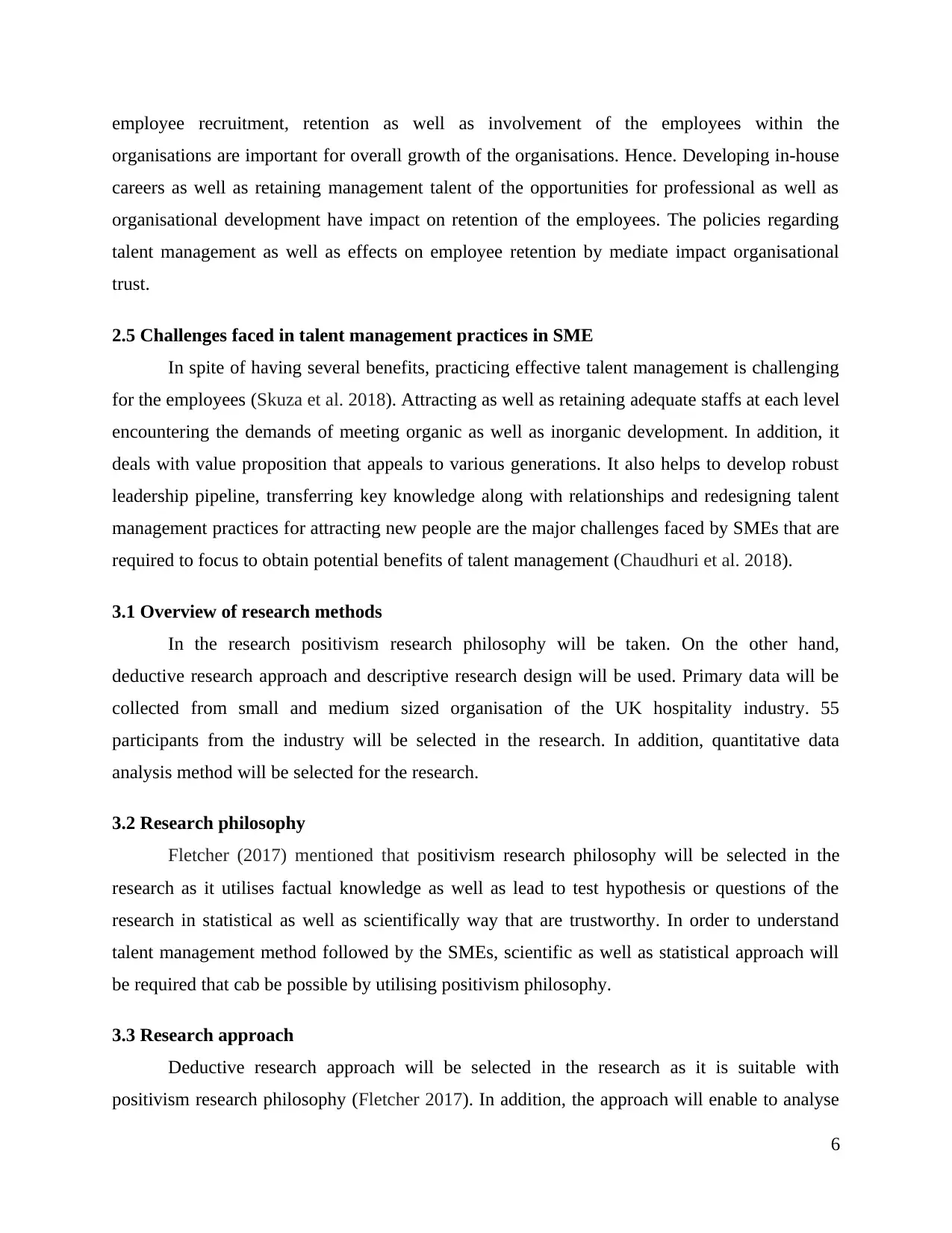
employee recruitment, retention as well as involvement of the employees within the
organisations are important for overall growth of the organisations. Hence. Developing in-house
careers as well as retaining management talent of the opportunities for professional as well as
organisational development have impact on retention of the employees. The policies regarding
talent management as well as effects on employee retention by mediate impact organisational
trust.
2.5 Challenges faced in talent management practices in SME
In spite of having several benefits, practicing effective talent management is challenging
for the employees (Skuza et al. 2018). Attracting as well as retaining adequate staffs at each level
encountering the demands of meeting organic as well as inorganic development. In addition, it
deals with value proposition that appeals to various generations. It also helps to develop robust
leadership pipeline, transferring key knowledge along with relationships and redesigning talent
management practices for attracting new people are the major challenges faced by SMEs that are
required to focus to obtain potential benefits of talent management (Chaudhuri et al. 2018).
3.1 Overview of research methods
In the research positivism research philosophy will be taken. On the other hand,
deductive research approach and descriptive research design will be used. Primary data will be
collected from small and medium sized organisation of the UK hospitality industry. 55
participants from the industry will be selected in the research. In addition, quantitative data
analysis method will be selected for the research.
3.2 Research philosophy
Fletcher (2017) mentioned that positivism research philosophy will be selected in the
research as it utilises factual knowledge as well as lead to test hypothesis or questions of the
research in statistical as well as scientifically way that are trustworthy. In order to understand
talent management method followed by the SMEs, scientific as well as statistical approach will
be required that cab be possible by utilising positivism philosophy.
3.3 Research approach
Deductive research approach will be selected in the research as it is suitable with
positivism research philosophy (Fletcher 2017). In addition, the approach will enable to analyse
6
organisations are important for overall growth of the organisations. Hence. Developing in-house
careers as well as retaining management talent of the opportunities for professional as well as
organisational development have impact on retention of the employees. The policies regarding
talent management as well as effects on employee retention by mediate impact organisational
trust.
2.5 Challenges faced in talent management practices in SME
In spite of having several benefits, practicing effective talent management is challenging
for the employees (Skuza et al. 2018). Attracting as well as retaining adequate staffs at each level
encountering the demands of meeting organic as well as inorganic development. In addition, it
deals with value proposition that appeals to various generations. It also helps to develop robust
leadership pipeline, transferring key knowledge along with relationships and redesigning talent
management practices for attracting new people are the major challenges faced by SMEs that are
required to focus to obtain potential benefits of talent management (Chaudhuri et al. 2018).
3.1 Overview of research methods
In the research positivism research philosophy will be taken. On the other hand,
deductive research approach and descriptive research design will be used. Primary data will be
collected from small and medium sized organisation of the UK hospitality industry. 55
participants from the industry will be selected in the research. In addition, quantitative data
analysis method will be selected for the research.
3.2 Research philosophy
Fletcher (2017) mentioned that positivism research philosophy will be selected in the
research as it utilises factual knowledge as well as lead to test hypothesis or questions of the
research in statistical as well as scientifically way that are trustworthy. In order to understand
talent management method followed by the SMEs, scientific as well as statistical approach will
be required that cab be possible by utilising positivism philosophy.
3.3 Research approach
Deductive research approach will be selected in the research as it is suitable with
positivism research philosophy (Fletcher 2017). In addition, the approach will enable to analyse
6
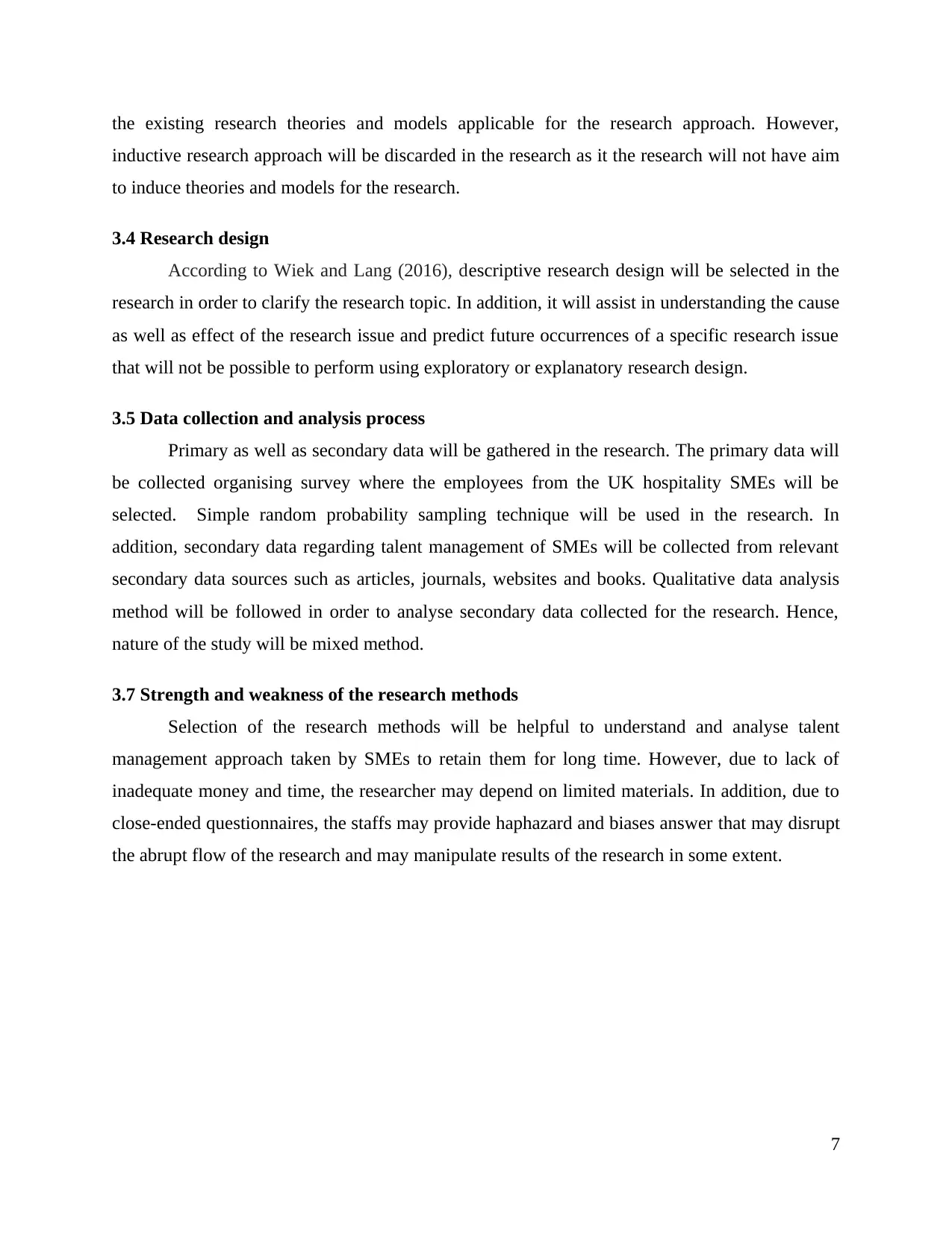
the existing research theories and models applicable for the research approach. However,
inductive research approach will be discarded in the research as it the research will not have aim
to induce theories and models for the research.
3.4 Research design
According to Wiek and Lang (2016), descriptive research design will be selected in the
research in order to clarify the research topic. In addition, it will assist in understanding the cause
as well as effect of the research issue and predict future occurrences of a specific research issue
that will not be possible to perform using exploratory or explanatory research design.
3.5 Data collection and analysis process
Primary as well as secondary data will be gathered in the research. The primary data will
be collected organising survey where the employees from the UK hospitality SMEs will be
selected. Simple random probability sampling technique will be used in the research. In
addition, secondary data regarding talent management of SMEs will be collected from relevant
secondary data sources such as articles, journals, websites and books. Qualitative data analysis
method will be followed in order to analyse secondary data collected for the research. Hence,
nature of the study will be mixed method.
3.7 Strength and weakness of the research methods
Selection of the research methods will be helpful to understand and analyse talent
management approach taken by SMEs to retain them for long time. However, due to lack of
inadequate money and time, the researcher may depend on limited materials. In addition, due to
close-ended questionnaires, the staffs may provide haphazard and biases answer that may disrupt
the abrupt flow of the research and may manipulate results of the research in some extent.
7
inductive research approach will be discarded in the research as it the research will not have aim
to induce theories and models for the research.
3.4 Research design
According to Wiek and Lang (2016), descriptive research design will be selected in the
research in order to clarify the research topic. In addition, it will assist in understanding the cause
as well as effect of the research issue and predict future occurrences of a specific research issue
that will not be possible to perform using exploratory or explanatory research design.
3.5 Data collection and analysis process
Primary as well as secondary data will be gathered in the research. The primary data will
be collected organising survey where the employees from the UK hospitality SMEs will be
selected. Simple random probability sampling technique will be used in the research. In
addition, secondary data regarding talent management of SMEs will be collected from relevant
secondary data sources such as articles, journals, websites and books. Qualitative data analysis
method will be followed in order to analyse secondary data collected for the research. Hence,
nature of the study will be mixed method.
3.7 Strength and weakness of the research methods
Selection of the research methods will be helpful to understand and analyse talent
management approach taken by SMEs to retain them for long time. However, due to lack of
inadequate money and time, the researcher may depend on limited materials. In addition, due to
close-ended questionnaires, the staffs may provide haphazard and biases answer that may disrupt
the abrupt flow of the research and may manipulate results of the research in some extent.
7
Paraphrase This Document
Need a fresh take? Get an instant paraphrase of this document with our AI Paraphraser
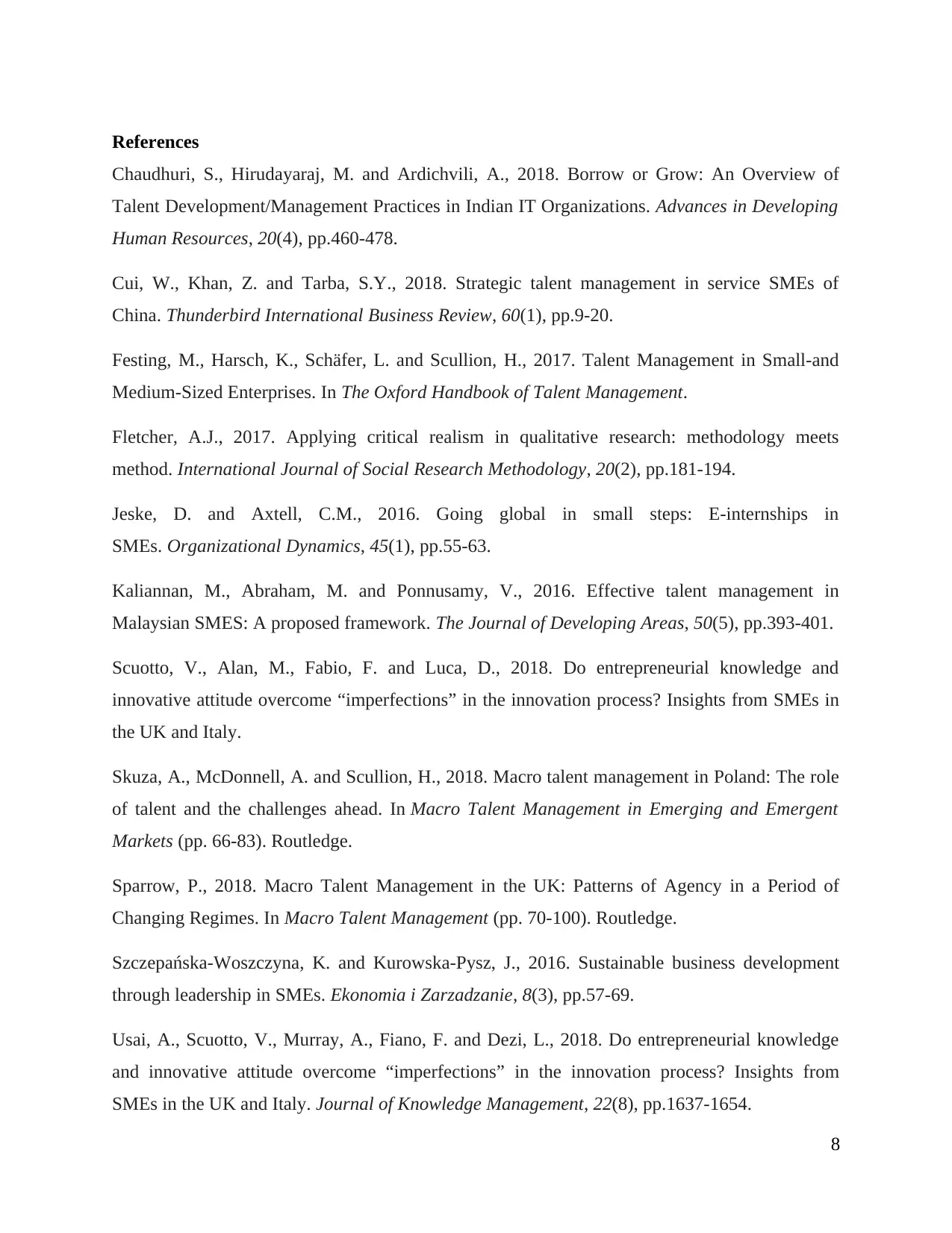
References
Chaudhuri, S., Hirudayaraj, M. and Ardichvili, A., 2018. Borrow or Grow: An Overview of
Talent Development/Management Practices in Indian IT Organizations. Advances in Developing
Human Resources, 20(4), pp.460-478.
Cui, W., Khan, Z. and Tarba, S.Y., 2018. Strategic talent management in service SMEs of
China. Thunderbird International Business Review, 60(1), pp.9-20.
Festing, M., Harsch, K., Schäfer, L. and Scullion, H., 2017. Talent Management in Small-and
Medium-Sized Enterprises. In The Oxford Handbook of Talent Management.
Fletcher, A.J., 2017. Applying critical realism in qualitative research: methodology meets
method. International Journal of Social Research Methodology, 20(2), pp.181-194.
Jeske, D. and Axtell, C.M., 2016. Going global in small steps: E-internships in
SMEs. Organizational Dynamics, 45(1), pp.55-63.
Kaliannan, M., Abraham, M. and Ponnusamy, V., 2016. Effective talent management in
Malaysian SMES: A proposed framework. The Journal of Developing Areas, 50(5), pp.393-401.
Scuotto, V., Alan, M., Fabio, F. and Luca, D., 2018. Do entrepreneurial knowledge and
innovative attitude overcome “imperfections” in the innovation process? Insights from SMEs in
the UK and Italy.
Skuza, A., McDonnell, A. and Scullion, H., 2018. Macro talent management in Poland: The role
of talent and the challenges ahead. In Macro Talent Management in Emerging and Emergent
Markets (pp. 66-83). Routledge.
Sparrow, P., 2018. Macro Talent Management in the UK: Patterns of Agency in a Period of
Changing Regimes. In Macro Talent Management (pp. 70-100). Routledge.
Szczepańska-Woszczyna, K. and Kurowska-Pysz, J., 2016. Sustainable business development
through leadership in SMEs. Ekonomia i Zarzadzanie, 8(3), pp.57-69.
Usai, A., Scuotto, V., Murray, A., Fiano, F. and Dezi, L., 2018. Do entrepreneurial knowledge
and innovative attitude overcome “imperfections” in the innovation process? Insights from
SMEs in the UK and Italy. Journal of Knowledge Management, 22(8), pp.1637-1654.
8
Chaudhuri, S., Hirudayaraj, M. and Ardichvili, A., 2018. Borrow or Grow: An Overview of
Talent Development/Management Practices in Indian IT Organizations. Advances in Developing
Human Resources, 20(4), pp.460-478.
Cui, W., Khan, Z. and Tarba, S.Y., 2018. Strategic talent management in service SMEs of
China. Thunderbird International Business Review, 60(1), pp.9-20.
Festing, M., Harsch, K., Schäfer, L. and Scullion, H., 2017. Talent Management in Small-and
Medium-Sized Enterprises. In The Oxford Handbook of Talent Management.
Fletcher, A.J., 2017. Applying critical realism in qualitative research: methodology meets
method. International Journal of Social Research Methodology, 20(2), pp.181-194.
Jeske, D. and Axtell, C.M., 2016. Going global in small steps: E-internships in
SMEs. Organizational Dynamics, 45(1), pp.55-63.
Kaliannan, M., Abraham, M. and Ponnusamy, V., 2016. Effective talent management in
Malaysian SMES: A proposed framework. The Journal of Developing Areas, 50(5), pp.393-401.
Scuotto, V., Alan, M., Fabio, F. and Luca, D., 2018. Do entrepreneurial knowledge and
innovative attitude overcome “imperfections” in the innovation process? Insights from SMEs in
the UK and Italy.
Skuza, A., McDonnell, A. and Scullion, H., 2018. Macro talent management in Poland: The role
of talent and the challenges ahead. In Macro Talent Management in Emerging and Emergent
Markets (pp. 66-83). Routledge.
Sparrow, P., 2018. Macro Talent Management in the UK: Patterns of Agency in a Period of
Changing Regimes. In Macro Talent Management (pp. 70-100). Routledge.
Szczepańska-Woszczyna, K. and Kurowska-Pysz, J., 2016. Sustainable business development
through leadership in SMEs. Ekonomia i Zarzadzanie, 8(3), pp.57-69.
Usai, A., Scuotto, V., Murray, A., Fiano, F. and Dezi, L., 2018. Do entrepreneurial knowledge
and innovative attitude overcome “imperfections” in the innovation process? Insights from
SMEs in the UK and Italy. Journal of Knowledge Management, 22(8), pp.1637-1654.
8

Wiek, A. and Lang, D.J., 2016. Transformational sustainability research methodology.
In Sustainability science (pp. 31-41). Springer, Dordrecht.
9
In Sustainability science (pp. 31-41). Springer, Dordrecht.
9

10
1 out of 10
Related Documents
Your All-in-One AI-Powered Toolkit for Academic Success.
+13062052269
info@desklib.com
Available 24*7 on WhatsApp / Email
![[object Object]](/_next/static/media/star-bottom.7253800d.svg)
Unlock your academic potential
© 2024 | Zucol Services PVT LTD | All rights reserved.





